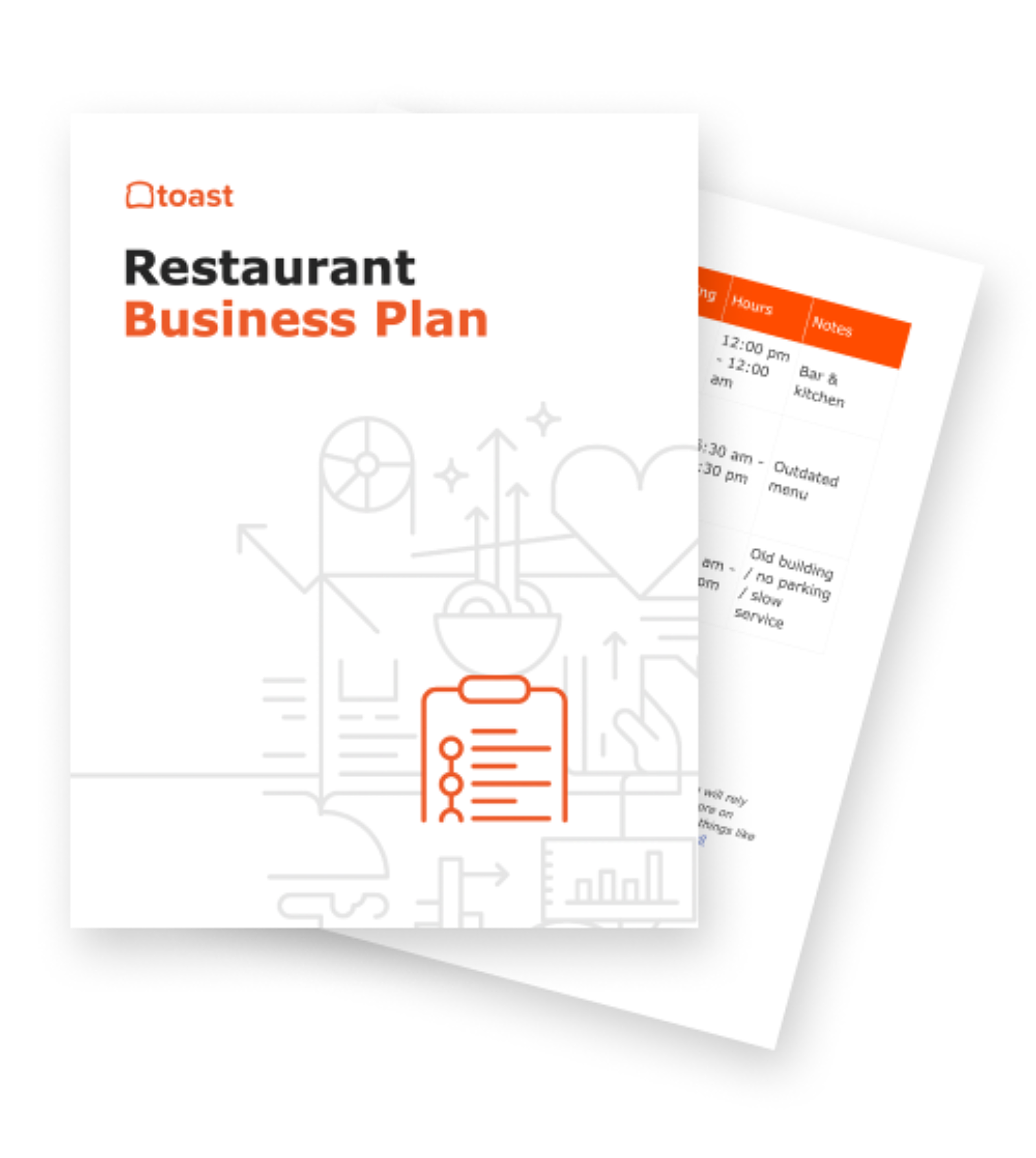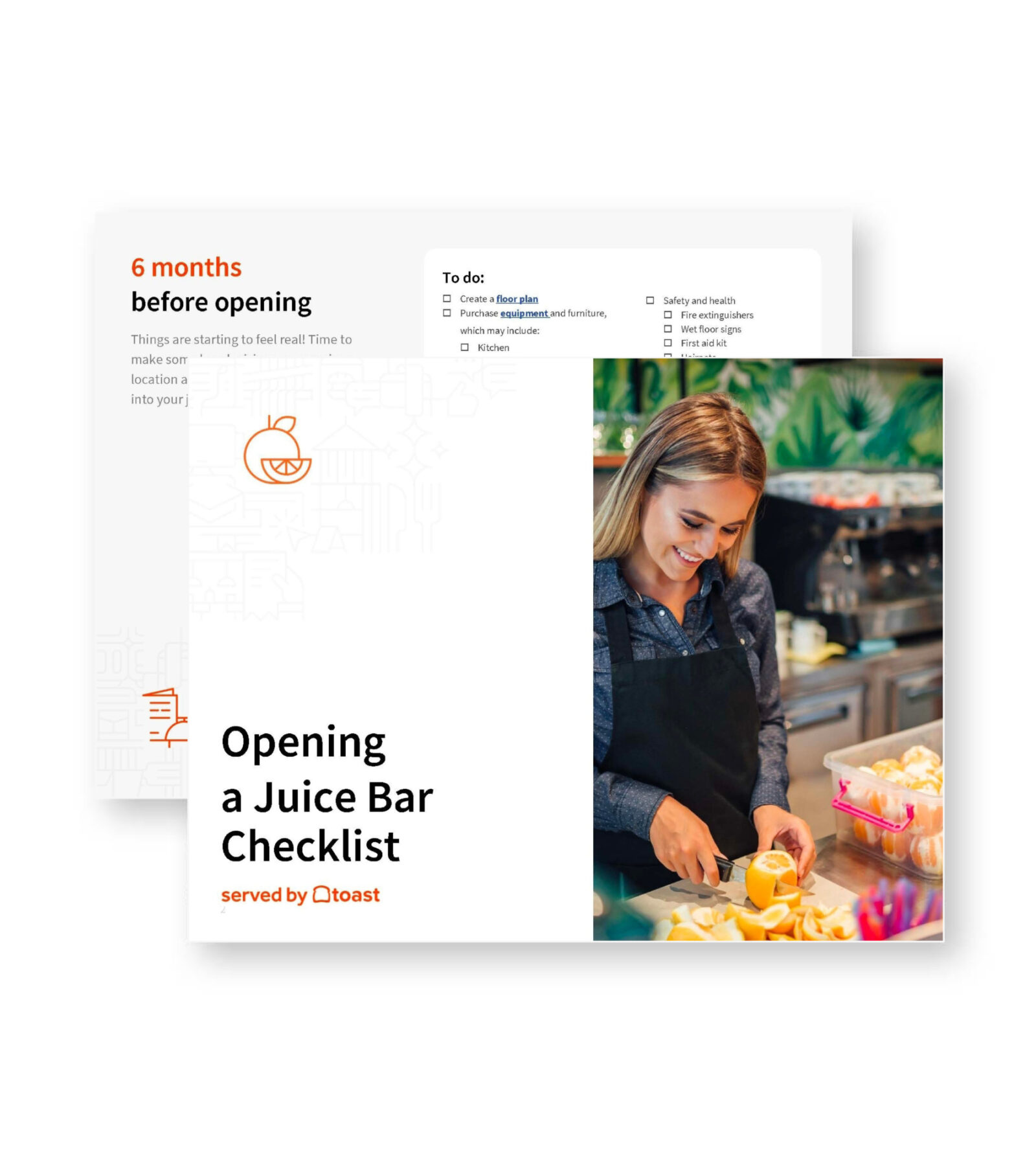
How To Write a Juice Bar Business Plan
Squeezed, cold-pressed, or blended, fresh juice is a health craze that’s here to stay – start your juice bar business plan with this template.
Tyler MartinezAuthor


Restaurant Business Plan Template
No matter where you’re at in your restaurant ownership journey, a business plan will be your north star. Organize your vision and ensure that nothing is overlooked with this free template.
Get free downloadBusiness Plan for Juice Bars Guide
Juice bars and smoothie shops are relatively low-cost restaurant ventures, but the business model can be a little risky when compared with some other food business models. Health-conscious consumers will pay premiums for fresh, creative, and nutritious juices but they likely won’t go too far out of their way to find them. In other words, location is everything when it comes to starting a juice bar. Set up shop near a gym, a trail head, an outdoors club meeting spot, or an outdoors equipment store — you'll want to make sure you're right where your target customers are.
Starting costs for your juice bar include finding and outfitting the ideal commercial space to rent or lease, purchasing equipment, building a menu, generating brand awareness, and hiring and training staff.
Opening any kind of food business is a process with dozens, if not hundreds, of little steps. That's why creating a juice bar business plan is so crucial: working with a clear roadmap toward your juice bar dreams will help every step of your venture go as smoothly as possible.
Why You Need a Juice Bar Business Plan
Attracting potential investors or partners for your juice bar requires providing detailed information about the potential rewards and risks of financing your business. A business plan helps you get all the details sorted and acts as a resource for potential investors.
Juice bars are focused on fresh (sometimes cold-pressed) juices, smoothies, bowls and often salads or sandwiches. Juice bars have relatively low start-up costs, but they also have lower than average profit margins. Think about it: there's only so much you can charge for a juice, even if your customers know you use the best ingredients. Making the right decisions about location, expensive blending equipment, staffing, and supplying your store with fresh ingredients are critical because they form a single revenue stream.
How to Write a Juice Bar Business Plan (Description, Examples, Proposals)
Business plans are straightforward but, as with any writing project, it can be difficult to decide where to start and to put those first ideas for your juice bar into a document.
This fully customizable restaurant business plan template is easily adaptable to your juice bar – read on for useful tips for your juice bar’s business plan and what to put in it.
Related Restaurant Resources
Restaurant Business Plan Template
No matter where you’re at in your restaurant ownership journey, a business plan will be your north star. Organize your vision and ensure that nothing is overlooked with this free template.

Elements of a Juice Bar Business Plan
Executive Summary
Your business plan starts with a strong, concise introduction to the concept and goals of your juice bar in the form of an executive summary. Use this section to introduce key elements of your business. Include the vision for your products, key information about the juice bar, and the market in your location.
As you craft the executive summary, imagine the investors and partners that you want to attract with this plan. How might you catch the attention of the right investor for your concept that will engage productively with your vision for your juice bar?
This is also your chance to define the scale of your business. Provide projections for an expansion timeline and the earnings or investment expanding into other local or regional markets would require.
Company Overview
The company overview works with the executive summary to provide a reference for the rest of your business plan. It is more practical than attention-catching: it acts as a glossary for the rest of your business plan by introducing key information.
This section is where you can really flex your business prowess while defining your vision for a juice bar. Describe the products you will serve and provide information about the ownership structure and investors’ place in it. Consider including information about the role you plan to fill in your company, the roles you’ll need to find talent to fill, your vision for the customer experience, and a summary of financial projections.
Team and Management
Juice bars operate on relatively small staffs which can keep labor costs down but present potential setbacks as well – finding staffing coverage when key team members are ill or have emergencies will likely fall to management or onto you as the owner.
Use the team and management structure to outline the ownership structure of your business in detail. Make concrete plans for what kind of worker will manage your shops and how much staff you intend to employ so that you can make accurate financial projections later.
Sample Menu
The sample menu for a juice bar is the ground for a lot of decision-making since so much of the business is tied into the production equipment and supply chain. Investing in industrial blenders is a common and versatile approach, but some juice bars invest in pricey cold pressing technology to attract the choosiest of health enthusiasts. The equipment you invest in will determine the products you can produce.
Carefully consider how you will source fresh or frozen fruits and vegetables and how you will communicate about your ingredients to your customers. In the health food market, your consumer base will likely be curious about where your source ingredients and might even have questions about the sustainability of your supply chain.
Market Analysis
The location of your juice bar and the competition in that location, whether it be with other juice bars, health food stores, or smoothie shops, is critical for your market analysis. This section of your business plan asks you to define your market and present any research you’ve compiled on that market.
Are you planning to enter a potentially untapped market or will you be competing with large corporate smoothie chains? Providing these key details to potential investors in your business plan is critical. Consider projecting the demand for your products in your area to inform strategies for marketing and financial projections.
A market analysis is all about pinpointing those three key factors: target consumer, location, and competition. Provide research-backed information in your market analysis to really impress potential investors or partners.
Marketing and Publicity
Marketing and publicity is important for any food business: it takes work to get customers to your shop and keep them loyal.
Social media can be a powerful tool for spreading the word about a new business among potential customers. To keep them coming back, consider establishing a loyalty program that is more generous than the competitors in your area.
Branded Graphics
Realizing your artistic vision for your juice bar by creating or commissioning branded graphics is one of the most exciting aspects of planning to market your new business. Choose branding that conveys your juice bar’s concept to potential investors which will become the cornerstone of your customer’s experience of your brand.
Find ways to integrate a consistent aesthetic across the logo, cup design, menu boards, and social media campaigns so that your brand is coherent and recognizable to customers.
Restaurant Marketing Plan
Create a marketing plan that'll drive repeat business with this customizable marketing playbook template and interactive calendar.

Business Operations
The business operations section of your plan is arguably the most important because it covers everything from the daily routine of juice making to the ownership and management structure. Consider including information about how your juice bar will manage sales, inventory, and accounting while juggling demand and the supply chain.
The juice bar has one revenue stream – your location, equipment, labor, packaging, and brand are all focused on making and selling juices and other health foods. How you will manage the fluctuations in supply and demand, produce quality, and labor should be considered in this section.
Your business operations section acts as the north star for your business operations from the daily to the quarterly. Don’t spare any details in this section because you’ll fall back on it to field questions from potential investors and partners.
Restaurant POS Comparison Tool
A free, customizable Restaurant POS Comparison Tool to research and compare point of sale systems in one Excel spreadsheet.

Financing and Loans
Even as it is relatively inexpensive to start a juice bar, especially compared to a full-service restaurant, there are financial considerations that are part of opening any new business. It’s crucial to carefully consider your finances and prepare to apply for any necessary lines of credit or loans.
This financing guide is a helpful resource that goes into detail about loan options from brick-and-mortar banks, alternative loans, Small Business Association (SBA) loans, merchant cash advances, business lines of credit, crowdfunding, asking family or friends, commercial real estate loans, equipment financing, and purchase order funding.
Once you have a concrete plan to fund your new juice bar, write that information into your business plan to provide it to potential investors, including information about other partners and detailed financial plans with projections of the profits and expenses of your business.
Sales Forecasts and Operating Expenses
The operating expenses of a juice bar include labor, equipment, produce, insurance, water, ice machines, rent, marketing, etc. which should all be balanced against sales forecasts in this section of your business plan.
Business plans commonly include a “break-even analysis” which compares the sales required to break even with the cost of expenses each month. Investors will be interested in the potential for profit and loss in order to assess the risk of contributing to your business, but a profit and loss statement for a business that isn’t open yet requires some educated projections.
A cash flow analysis shows investors that the company can support itself without additional investments by detailing planned spending on labor, supplies, and operations. Be sure to consider how the costs unique to your juice bar, such as imported fruits or seasonal labor costs, balance at the end of each quarter.
How to Present Your Juice Bar Business Plan
There are a few ways to prepare to communicate with investors about your business plan and get them interested. First, send your business plan to investors and banks far and wide – put your concept and plan in the hands and minds of as many people as possible. You can’t hear no (or yes!) unless you ask.
Perhaps you’re at a networking event for local small restaurant owners and financers. You might want to have a 30-second elevator pitch prepared so that you can communicate everything you need to about your plan for your juice bar company quickly. Be sure to include something memorable or make an opportunity for questions to keep people talking. Maybe you create business cards that include a juice recipe on the back!
Once you secure a meeting with a potential investor or partner, you’ll want a more detailed presentation that presents all the key elements of your business plan – for a juice bar, that will include a tantalizing list of your best juice blend ideas, plus how you'll market them far and wide.
It’s good to anticipate potential questions and prepare answers for questions you encounter for the first time. When networking, be honest and genuine, even if you don’t have a ready answer for each question that comes your way – investors will be interested in your charisma and savvy just as much as your ability to build a detailed plan.
Related Juice Bar Resources
Restaurant Business Plan Template
No matter where you’re at in your restaurant ownership journey, a business plan will be your north star. Organize your vision and ensure that nothing is overlooked with this free template.

Is this article helpful?
DISCLAIMER: This information is provided for general informational purposes only, and publication does not constitute an endorsement. Toast does not warrant the accuracy or completeness of any information, text, graphics, links, or other items contained within this content. Toast does not guarantee you will achieve any specific results if you follow any advice herein. It may be advisable for you to consult with a professional such as a lawyer, accountant, or business advisor for advice specific to your situation.
Read More
Subscribe to On the Line
Sign up to get industry intel, advice, tools, and honest takes from real people tackling their restaurants’ greatest challenges.



